Monday, February 22, 2016
In
famous photographers,
great quotes,
inspiration,
photography,
the world of photography,
what does it stand for
by Unknown
//
9:55 AM
//
Leave a Comment
What is photography really about
Photography is the science, art and practice of creating durable images by recording light or other electromagnetic radiation, either electronically by means of an image sensor, or chemically by means of a light-sensitive material such as photographic film.
Typically, a lens is used to focus the light reflected or emitted from objects into a real image on the light-sensitive surface inside a cameraduring a timed exposure. With an electronic image sensor, this produces an electrical charge at each pixel, which is electronically processed and stored in a digital image file for subsequent display or processing. The result with photographic emulsion is an invisiblelatent image, which is later chemically "developed" into a visible image, either negative or positive depending on the purpose of the photographic material and the method of processing. A negative image on film is traditionally used to photographically create a positive image on a paper base, known as a print, either by using an enlarger or by contact printing.
Photography is employed in many fields of science, manufacturing (e.g., photolithography) and business, as well as its more direct uses for art, film and video production, recreational purposes, hobby, and mass communication.
The word "photography" was created from the Greek roots φωτός (phōtos), genitive of φῶς (phōs), "light" and γραφή (graphé) "representation by means of lines" or "drawing", together meaning "drawing with light".
Several people may have coined the same new term from these roots independently. Hercules Florence, a French painter and inventor living in Campinas, Brazil, used the French form of the word, photographie, in private notes which a Brazilian photography historian believes were written in 1834. Johann von Maedler, a Berlin astronomer, is credited in a 1932 German history of photography as having used it in an article published on 25 February 1839 in the German newspaper Vossische Zeitung.Both of these claims are now widely reported but apparently neither has ever been independently confirmed as beyond reasonable doubt. Credit has traditionally been given to Sir John Herschel both for coining the word and for introducing it to the public. His uses of it in private correspondence prior to 25 February 1839 and at his Royal Society lecture on the subject in London on 14 March 1839 have long been amply documented and accepted as settled facts.
Around the year 1800, Thomas Wedgwood made the first known attempt to capture the image in a camera obscura by means of a light-sensitive substance. He used paper or white leather treated with silver nitrate. Although he succeeded in capturing the shadows of objects placed on the surface in direct sunlight, and even made shadow-copies of paintings on glass, it was reported in 1802 that "the images formed by means of a camera obscura have been found too faint to produce, in any moderate time, an effect upon the nitrate of silver." The shadow images eventually darkened all over.
The first permanent photoetching was an image produced in 1822 by the French inventor Nicéphore Niépce, but it was destroyed in a later attempt to make prints from it. Niépce was successful again in 1825. In 1826 or 1827, he made the View from the Window at Le Gras, the earliest surviving photograph from nature (i.e., of the image of a real-world scene, as formed in a camera obscura by alens).
Because Niépce's camera photographs required an extremely long exposure (at least eight hours and probably several days), he sought to greatly improve his bitumen process or replace it with one that was more practical. In partnership with Louis Daguerre, he worked out post-exposure processing methods that produced visually superior results and replaced the bitumen with a more light-sensitive resin, but hours of exposure in the camera were still required. With an eye to eventual commercial exploitation, the partners opted for total secrecy.
Niépce died in 1833 and Daguerre then redirected the experiments toward the light-sensitive silver halides, which Niépce had abandoned many years earlier because of his inability to make the images he captured with them light-fast and permanent. Daguerre's efforts culminated in what would later be named the daguerreotype process, the essential elements of which were in place in 1837. The required exposure time was measured in minutes instead of hours. Daguerre took the earliest confirmed photograph of a person in 1838 while capturing a view of a Paris street: unlike the other pedestrian and horse-drawn traffic on the busy boulevard, which appears deserted, one man having his boots polished stood sufficiently still throughout the approximately ten-minute-long exposure to be visible. The existence of Daguerre's process was publicly announced, without details, on 7 January 1839. The news created an international sensation. France soon agreed to pay Daguerre a pension in exchange for the right to present his invention to the world as the gift of France, which occurred when complete working instructions were unveiled on 19 August 1839.
Meanwhile, in Brazil, Hercules Florence had apparently started working out a silver-salt-based paper process in 1832, later naming itPhotographie, and an English inventor, William Fox Talbot, succeeded in making crude but reasonably light-fast silver images on paper as early as 1834 but had kept his work secret. After reading about Daguerre's invention in January 1839, Talbot published his method and set about improving on it. At first, like other pre-daguerreotype processes, Talbot's paper-based photography typically required hours-long exposures in the camera, but in 1840 he created the calotype process, with exposures comparable to the daguerreotype. In both its original and calotype forms, Talbot's process, unlike Daguerre's, created a translucent negative which could be used to print multiple positive copies, the basis of most chemical photography up to the present day. Daguerreotypes could only be replicated by rephotographing them with a camera. Talbot's famous tiny paper negative of the Oriel window in Lacock Abbey, one of a number of camera photographs he made in the summer of 1835, may be the oldest camera negative in existence.
John Herschel made many contributions to the new field. He invented the cyanotype process, later familiar as the "blueprint". He was the first to use the terms "photography", "negative" and "positive". He had discovered in 1819 that sodium thiosulphate was a solvent of silver halides, and in 1839 he informed Talbot (and, indirectly, Daguerre) that it could be used to "fix" silver-halide-based photographs and make them completely light-fast. He made the first glass negative in late 1839.
In the March 1851 issue of The Chemist, Frederick Scott Archer published his wet plate collodion process. It became the most widely used photographic medium until the gelatin dry plate, introduced in the 1870s, eventually replaced it. There are three subsets to the collodion process; the Ambrotype (a positive image on glass), the Ferrotype or Tintype (a positive image on metal) and the glass negative, which was used to make positive prints on albumen or salted paper.
Many advances in photographic glass plates and printing were made during the rest of the 19th century. In 1891, Gabriel Lippmann introduced a process for making natural-color photographs based on the optical phenomenon of the interference of light waves. His scientifically elegant and important but ultimately impractical invention earned him the Nobel Prize for Physics in 1908.
Glass plates were the medium for most original camera photography from the late 1850s until the general introduction of flexible plastic films during the 1890s. Although the convenience of film greatly popularized amateur photography, early films were somewhat more expensive and of markedly lower optical quality than their glass plate equivalents, and until the late 1910s they were not available in the large formats preferred by most professional photographers, so the new medium did not immediately or completely replace the old. Because of the superior dimensional stability of glass, the use of plates for some scientific applications, such as astrophotography, continued into the 1990s, and in the niche field of laser holography it has persisted into the 2010s.
Tuesday, January 19, 2016
In
beginning,
birth of camera,
digital cameras,
evolution of camera,
SLR,
TLR
by Unknown
//
11:29 AM
//
1 comment
Evolution of Cameras
The history of the camera can be traced much further back than the introduction of photography. Cameras evolved from thecamera obscura, and continued to change through many generations of photographic technology, including daguerreotypes,calotypes, dry plates, film, and digital cameras.
Camera obscura
Photographic cameras were a development of the camera obscura, a device possibly dating back to the ancient Chinese and ancient Greeks which uses a pinhole or lens to project an image of the scene outside upside-down onto a viewing surface.
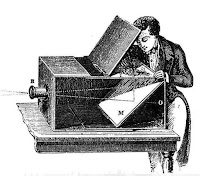 An Arab physicist, Ibn al-Haytham, published his Book of Optics in 1021 AD. He created the first pinhole camera after observing how light traveled through a window shutter. Ibn al-Haytham realized that smaller holes would create sharper images. Ibn al-Haytham is also credited with inventing the first camera obscura.
An Arab physicist, Ibn al-Haytham, published his Book of Optics in 1021 AD. He created the first pinhole camera after observing how light traveled through a window shutter. Ibn al-Haytham realized that smaller holes would create sharper images. Ibn al-Haytham is also credited with inventing the first camera obscura.
After Niépce's death in 1833, his partner Louis Daguerre continued to experiment and by 1837 had created the first practical photographic process, which he named the daguerreotype and publicly unveiled in 1839. Daguerre treated a silver-plated sheet of copper with iodine vapor to give it a coating of light-sensitive silver iodide. After exposure in the camera, the image was developed by mercury vapor and fixed with a strong solution of ordinary salt (sodium chloride). Henry Fox Talbot perfected a different process, the calotype, in 1840. As commercialized, both processes used very simple cameras consisting of two nested boxes. The rear box had a removable ground glass screen and could slide in and out to adjust the focus. After focusing, the ground glass was replaced with a light-tight holder containing the sensitized plate or paper and the lens was capped. Then the photographer opened the front cover of the holder, uncapped the lens, and counted off as many seconds—or minutes—as the lighting conditions seemed to require before replacing the cap and closing the holder. Despite this mechanical simplicity, high-quality achromatic lenses were standard.
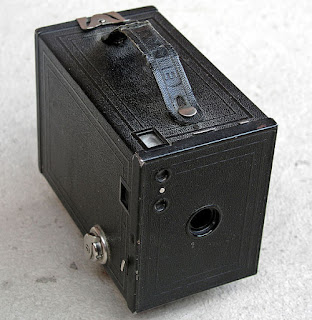 The use of photographic film was pioneered by George Eastman, who started manufacturing paper film in 1885 before switching to celluloid in 1889. His first camera, which he called the "Kodak," was first offered for sale in 1888. It was a very simple box camera with a fixed-focus lens and single shutter speed, which along with its relatively low price appealed to the average consumer. The Kodak came pre-loaded with enough film for 100 exposures and needed to be sent back to the factory for processing and reloading when the roll was finished. By the end of the 19th century Eastman had expanded his lineup to several models including both box and folding cameras.
The use of photographic film was pioneered by George Eastman, who started manufacturing paper film in 1885 before switching to celluloid in 1889. His first camera, which he called the "Kodak," was first offered for sale in 1888. It was a very simple box camera with a fixed-focus lens and single shutter speed, which along with its relatively low price appealed to the average consumer. The Kodak came pre-loaded with enough film for 100 exposures and needed to be sent back to the factory for processing and reloading when the roll was finished. By the end of the 19th century Eastman had expanded his lineup to several models including both box and folding cameras.
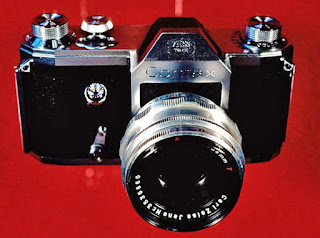 The first practical reflex camera was the Franke & Heidecke Rolleiflex medium format TLR of 1928. Though both single- and twin-lens reflex cameras had been available for decades, they were too bulky to achieve much popularity. The Rolleiflex, however, was sufficiently compact to achieve widespread popularity and the medium-format TLR design became popular for both high- and low-end cameras.
The first practical reflex camera was the Franke & Heidecke Rolleiflex medium format TLR of 1928. Though both single- and twin-lens reflex cameras had been available for decades, they were too bulky to achieve much popularity. The Rolleiflex, however, was sufficiently compact to achieve widespread popularity and the medium-format TLR design became popular for both high- and low-end cameras.
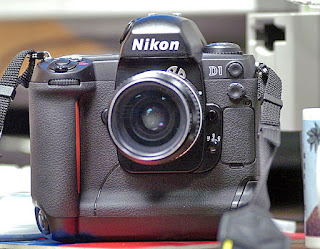 The move to digital formats was helped by the formation of the first JPEG and MPEG standards in 1988, which allowed image and video files to be compressed for storage. The first consumer camera with a liquid crystal display on the back was the Casio QV-10 developed by a team led by Hiroyuki Suetaka in 1995. The first camera to use CompactFlash was the Kodak DC-25 in 1996. The first camera that offered the ability to record video clips may have been the Ricoh RDC-1 in 1995.
The move to digital formats was helped by the formation of the first JPEG and MPEG standards in 1988, which allowed image and video files to be compressed for storage. The first consumer camera with a liquid crystal display on the back was the Casio QV-10 developed by a team led by Hiroyuki Suetaka in 1995. The first camera to use CompactFlash was the Kodak DC-25 in 1996. The first camera that offered the ability to record video clips may have been the Ricoh RDC-1 in 1995.
Camera obscura
Photographic cameras were a development of the camera obscura, a device possibly dating back to the ancient Chinese and ancient Greeks which uses a pinhole or lens to project an image of the scene outside upside-down onto a viewing surface.
 An Arab physicist, Ibn al-Haytham, published his Book of Optics in 1021 AD. He created the first pinhole camera after observing how light traveled through a window shutter. Ibn al-Haytham realized that smaller holes would create sharper images. Ibn al-Haytham is also credited with inventing the first camera obscura.
An Arab physicist, Ibn al-Haytham, published his Book of Optics in 1021 AD. He created the first pinhole camera after observing how light traveled through a window shutter. Ibn al-Haytham realized that smaller holes would create sharper images. Ibn al-Haytham is also credited with inventing the first camera obscura.
On 24 January 1544 mathematician and instrument maker Reiners Gemma Frisius of Leuven University used one to watch a solar eclipse, publishing a diagram of his method in De Radio Astronimica et Geometrico in the following year. In 1558 Giovanni Batista della Porta was the first to recommend the method as an aid to drawing.
Before the invention of photographic processes there was no way to preserve the images produced by these cameras apart from manually tracing them. The earliest cameras were room-sized, with space for one or more people inside; these gradually evolved into more and more compact models such as that by Niépce's time portable handheld cameras suitable for photography were readily available. The first camera that was small and portable enough to be practical for photography was envisioned by Johann Zahn in 1685, though it would be almost 150 years before such an application was possible.
Early fixed images
The first partially successful photograph of a camera image was made in approximately 1816 by Nicéphore Niépce, using a very small camera of his own making and a piece of paper coated with silver chloride, which darkened where it was exposed to light. No means of removing the remaining unaffected silver chloride was known to Niépce, so the photograph was not permanent, eventually becoming entirely darkened by the overall exposure to light necessary for viewing it. In the mid-1820s, Niépce used a sliding wooden box camera made by Parisian opticians Charles and Vincent Chevalier to experiment with photography on surfaces thinly coated with Bitumen of Judea. The bitumen slowly hardened in the brightest areas of the image. The unhardened bitumen was then dissolved away. One of those photographs has survived.
Daguerrotypes and Calotypes
Kodak and the birth of film
 The use of photographic film was pioneered by George Eastman, who started manufacturing paper film in 1885 before switching to celluloid in 1889. His first camera, which he called the "Kodak," was first offered for sale in 1888. It was a very simple box camera with a fixed-focus lens and single shutter speed, which along with its relatively low price appealed to the average consumer. The Kodak came pre-loaded with enough film for 100 exposures and needed to be sent back to the factory for processing and reloading when the roll was finished. By the end of the 19th century Eastman had expanded his lineup to several models including both box and folding cameras.
The use of photographic film was pioneered by George Eastman, who started manufacturing paper film in 1885 before switching to celluloid in 1889. His first camera, which he called the "Kodak," was first offered for sale in 1888. It was a very simple box camera with a fixed-focus lens and single shutter speed, which along with its relatively low price appealed to the average consumer. The Kodak came pre-loaded with enough film for 100 exposures and needed to be sent back to the factory for processing and reloading when the roll was finished. By the end of the 19th century Eastman had expanded his lineup to several models including both box and folding cameras.
In 1900, Eastman took mass-market photography one step further with the Brownie, a simple and very inexpensive box camera that introduced the concept of the snapshot. The Brownie was extremely popular and various models remained on sale until the 1960s.
Film also allowed the movie camera to develop from an expensive toy to a practical commercial tool.
Despite the advances in low-cost photography made possible by Eastman, plate cameras still offered higher-quality prints and remained popular well into the 20th century. To compete with roll film cameras, which offered a larger number of exposures per loading, many inexpensive plate cameras from this era were equipped with magazines to hold several plates at once. Special backs for plate cameras allowing them to use film packs or roll film were also available, as were backs that enabled rollfilm cameras to use plates.
Except for a few special types such as Schmidt cameras, most professional astrographs continued to use plates until the end of the 20th century when electronic photography replaced them.
TLRs and SLRs
 The first practical reflex camera was the Franke & Heidecke Rolleiflex medium format TLR of 1928. Though both single- and twin-lens reflex cameras had been available for decades, they were too bulky to achieve much popularity. The Rolleiflex, however, was sufficiently compact to achieve widespread popularity and the medium-format TLR design became popular for both high- and low-end cameras.
The first practical reflex camera was the Franke & Heidecke Rolleiflex medium format TLR of 1928. Though both single- and twin-lens reflex cameras had been available for decades, they were too bulky to achieve much popularity. The Rolleiflex, however, was sufficiently compact to achieve widespread popularity and the medium-format TLR design became popular for both high- and low-end cameras.
A similar revolution in SLR design began in 1933 with the introduction of the Ihagee Exakta, a compact SLR which used 127 rollfilm. This was followed three years later by the first Western SLR to use 135 film, the Kine Exakta (World's first true 35mm SLR was Soviet "Sport" camera, marketed several months before Kine Exakta, though "Sport" used its own film cartridge). The 35mm SLR design gained immediate popularity and there was an explosion of new models and innovative features after World War II. There were also a few 35mm TLRs, the best-known of which was the Contaflex of 1935, but for the most part these met with little success.
The first major post-war SLR innovation was the eye-level viewfinder, which first appeared on the Hungarian Duflex in 1947 and was refined in 1948 with the Contax S, the first camera to use a pentaprism. Prior to this, all SLRs were equipped with waist-level focusing screens. The Duflex was also the first SLR with an instant-return mirror, which prevented the viewfinder from being blacked out after each exposure. This same time period also saw the introduction of the Hasselblad 1600F, which set the standard for medium format SLRs for decades.
In 1952 the Asahi Optical Company (which later became well known for its Pentax cameras) introduced the first Japanese SLR using 135 film, the Asahiflex. Several other Japanese camera makers also entered the SLR market in the 1950s, including Canon, Yashica, and Nikon. Nikon's entry, the Nikon F, had a full line of interchangeable components and accessories and is generally regarded as the first Japanese system camera. It was the F, along with the earlier S series of rangefinder cameras, that helped establish Nikon's reputation as a maker of professional-quality equipment.
Arrival of true digital cameras
By the late 1980s, the technology required to produce truly commercial digital cameras existed. The first true portable digital camera that recorded images as a computerized file was likely the Fuji DS-1P of 1988, which recorded to a 2 MB SRAM memory card that used a battery to keep the data in memory. This camera was never marketed to the public.
The first digital camera of any kind ever sold commercially was possibly the MegaVision Tessera in 1987 though there is not extensive documentation of its sale known. The first portable digital camera that was actually marketed commercially was sold in December 1989 in Japan, the DS-X by Fuji The first commercially available portable digital camera in the United States was the Dycam Model 1, first shipped in November 1990. It was originally a commercial failure because it was black and white, low in resolution, and cost nearly $1,000 (about $2000 in 2014). It later saw modest success when it was re-sold as the Logitech Fotoman in 1992. It used a CCD image sensor, stored pictures digitally, and connected directly to a computer for download.
In 1991, Kodak brought to market the Kodak DCS (Kodak Digital Camera System), the beginning of a long line of professional Kodak DCSSLR cameras that were based in part on film bodies, often Nikons. It used a 1.3 megapixel sensor, had a bulky external digital storage system and was priced at $13,000. At the arrival of the Kodak DCS-200, the Kodak DCS was dubbed Kodak DCS-100.
 The move to digital formats was helped by the formation of the first JPEG and MPEG standards in 1988, which allowed image and video files to be compressed for storage. The first consumer camera with a liquid crystal display on the back was the Casio QV-10 developed by a team led by Hiroyuki Suetaka in 1995. The first camera to use CompactFlash was the Kodak DC-25 in 1996. The first camera that offered the ability to record video clips may have been the Ricoh RDC-1 in 1995.
The move to digital formats was helped by the formation of the first JPEG and MPEG standards in 1988, which allowed image and video files to be compressed for storage. The first consumer camera with a liquid crystal display on the back was the Casio QV-10 developed by a team led by Hiroyuki Suetaka in 1995. The first camera to use CompactFlash was the Kodak DC-25 in 1996. The first camera that offered the ability to record video clips may have been the Ricoh RDC-1 in 1995.
In 1995 Minolta introduced the RD-175, which was based on the Minolta 500si SLR with a splitter and three independent CCDs. This combination delivered 1.75M pixels. The benefit of using an SLR base was the ability to use any existing Minolta AF mount lens. 1999 saw the introduction of the Nikon D1, a 2.74 megapixel camera that was the first digital SLR developed entirely from the ground up by a major manufacturer, and at a cost of under $6,000 at introduction was affordable by professional photographers and high-end consumers. This camera also used Nikon F-mount lenses, which meant film photographers could use many of the same lenses they already owned.
Digital camera sales continued to flourish, driven by technology advances. The digital market segmented into different categories, Compact Digital Still Cameras, Bridge Cameras, Mirrorless Compacts and Digital SLRs. One of the major technology advances was the development of CMOS sensors, which helped drive sensor costs low enough to enable the widespread adoption of camera phones.
Source: Wikipedia
Monday, January 18, 2016
Getting into the World of Photography
"Photography
takes an instant out of time, altering life by holding it still."
-Dorothea Lange
Ahh.. So true. Photography is not only about capturing what you see. Photography is about expressing your emotions, your thought process, your state of mind. Writers write books to express themselves, dancers dance their hearts out, a sketch artists brings their sketches to life with their beautiful drawings, sculptors, magicians, painters, chefs, everybody has "outlets", if I may, for their emotions. Similarly we photographers express ourselves through the photographs we take. That's the the main reason I got into photography. I'm kind of an introvert so I wanted a medium through which I could express myself.. painting, dancing takes years to practice and decades to master. Hence photography. 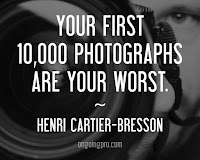 It was not like I always wanted to do Photography. Frankly I had no idea that this went this deep. It was only 3 years back I first tried used an SLR. My uncle who was practising photography at the time took me to his farm house, gave me his camera taught me the basics like exposure control and aperture and ISO and just told me to take pictures of whatever I felt like. I went around his farm and clicked a few pictures mostly nature and he was quite impressed. It was then I realised that I had the basic skill set of becoming a photographer and ever since that day I've been leaning the art of photography.
It was not like I always wanted to do Photography. Frankly I had no idea that this went this deep. It was only 3 years back I first tried used an SLR. My uncle who was practising photography at the time took me to his farm house, gave me his camera taught me the basics like exposure control and aperture and ISO and just told me to take pictures of whatever I felt like. I went around his farm and clicked a few pictures mostly nature and he was quite impressed. It was then I realised that I had the basic skill set of becoming a photographer and ever since that day I've been leaning the art of photography.Photography is a very vast field. Oh my God you have no idea how many categories or genre of photography there are. Each with a unique style and specific equipments. For starters, there is
1. Fashion photography
2. Nature photography
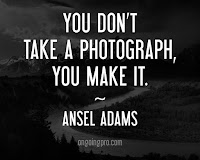 3. Wildlife photography
3. Wildlife photography4. Black and White photography
5. Wedding photography
6. Travel Photography
7. Time Lapse photography and many many many more. Trust me there are so many more different kinds of photography. I would say there are at least another 30 kinds of photography. It's your choice what kind of photography you want to get into. No one can tell you what kind of a photographer you are. Oh no no. You have to find out for yourself. One can only guide you or give you some basic knowledge, tips on handling an SLR, some Dos and Donts. The basic stuff. And that is what I intend to do with this blog. If you like to do photography and been wanting to, hopefully this MIGHT help you to get a perspective and a rough idea of what its like.
Choosing an Instrument:
A pen is to a Calligraphic artist is as a DSLR is to a photographer.
I started off with my uncles Nikon DSLR. I used it for almost a year before I bought my own. I would suggest you do the same. Just to be on a safer side. If you know what you're buying then chances of you regretting it will be virtually non existent. I'm sure at least one person you know has an SLR. Borrow it for a few days. It may be a Nikon or a Canon.
People often ask me which is better Nikon or Canon. It's like asking which is better Pepsi or Coca-cola or Samsung or Apple or PS4 or XBOX one. It's more like a personal preference. The camera I have currently is a Nikon but I personally prefer a Canon. It's all comes down to personal preference. Like any other products, each has its own advantages and disadvantages. Like for example a Nikon is simpler to use when compared to a Canon. On the contrary a Canon offers more features than a Nikon. I am of course talking about the entry level DSLRs (Digital Single-Lens Reflex cameras). Not even the semi professional ones. I am talking about the entry level cameras for people who are getting into photography.
So like I said It all comes down to personal preferences. The best advice I can give is borrow a camera for a few days and see which one you prefer. A Canon or a Nikon.
The Beginning of Photography:
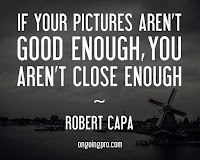 As I mentioned earlier, there are a lot of types of photography you can practice. If you ask me, the best way to begin photography is with bird photography. There is a very good reason behind this claim. As you begin using a DSLR (which isn't easy), there are things you have to do just before you take the picture. Like for instance adjust the exposure (shutter speed) which depends on the background. And controlling the ISO, and exposure component and depth of field. For the right photograph, you have to constantly keep on changing these parameters. How you know what parameters to vary how much to vary? By constantly using your DSLR. and I reckon starting off with bird photography will help you in a great way because birds are one of the most difficult to capture as they are constantly changing places.. Constantly flying off from one tree to another.. Which means the settings you adjusted to the previous frame is different from the current frame.. And most of the time you'll forget to change your settings. Doing bird photography requires a lot of patience, precision, and skill. At the same time you have to be quick with your equipment. Only when you get all these right, you get the PERFECT photograph and the amount of satisfaction you get when you capture the right one.. is unparalleled!
As I mentioned earlier, there are a lot of types of photography you can practice. If you ask me, the best way to begin photography is with bird photography. There is a very good reason behind this claim. As you begin using a DSLR (which isn't easy), there are things you have to do just before you take the picture. Like for instance adjust the exposure (shutter speed) which depends on the background. And controlling the ISO, and exposure component and depth of field. For the right photograph, you have to constantly keep on changing these parameters. How you know what parameters to vary how much to vary? By constantly using your DSLR. and I reckon starting off with bird photography will help you in a great way because birds are one of the most difficult to capture as they are constantly changing places.. Constantly flying off from one tree to another.. Which means the settings you adjusted to the previous frame is different from the current frame.. And most of the time you'll forget to change your settings. Doing bird photography requires a lot of patience, precision, and skill. At the same time you have to be quick with your equipment. Only when you get all these right, you get the PERFECT photograph and the amount of satisfaction you get when you capture the right one.. is unparalleled!
Buying The Right Lens:
DSLRs have interchangeable lenses. Meaning you can have multiple lens for a single body (body is what we refer to an SLR without the lens). Usually you'll get an 18-55mm (read as 18 to 55 mm) lens with your body. We call it a kit-lens. A kit-lens is the lens you get when you buy the camera.. The term "mm" refers to he focal length of the lens. It basically tells us the zoom capacity if the lens. Bigger the number higher is the zooming capacity. As simple as that. Sometimes you'll get 2 kit-lens with your camera (depends on the promotional offers offered by the respective companies). The second kit-lens you get is usually a 55-200mm lens. If you ask me you at least have to have a 300mm lens to do bird photography. 200mm is kind of pushing it. So I suggest.. Buy a body with the 18-55mm kit-lens and invest in a 70-300mm lens.
"The other things" refer to the commodities that keep your camera and lens clean. You should NEVER touch the lens let alone clean it with your cleaning cloth. You get specialised equipments to do that.. Such as a lens pen (used to clean the lens), a blower (used to blow off dust from your camera and lens), a special cleaning cloth, and so on. These things are not at all expensive and it is highly recommended if you want to maintain your equipment. Other "other things" include tripods, filters, wireless utilities, GPS devices and so on (more on that later).
So, conclusion.. You have you Camera, your lens, your goals and your vision. So what are you waiting for? The time is now. Photography is a beautiful thing. Once you begin you never stop. Grab your camera, put on your thinking hat and just go with it!
If i have left out on anything, please feel free to ask me anything. If you have any suggestions, please done hesitate to ask me.
Sunday, January 10, 2016
The Walk of life
Its amazing how things work out.. I've been wanting to write this post from January of last year. Finally found the time and motivation to complete it.
its been more than 4 years since my sister got married and moved to USA.. and yet the memory of her living here seems to be so fresh. I mean no surprises there we lived under the same roof for 18 years. My brother-in-law is a great guy. Very driven. Very focused.
Me and my sister were very close.. sure we would argue.. but we were so close. I used to think as she grew older and started college she would spend less time with me and more time with her peers. but fortunately that wasn't the case. She always took me out. She made plans with me she helped me out she was a great sister and she was a very reasonable person. She used to be patient with me and teach me and help me with my school stuff.. I was a slow learner she never lost her temper with me.
And as a second born, there are things you don't get to do. you don't get to create new rules. you only get to follow rules created by the first born. its the same in any household where i come from. let me give you an example.. my sister could stay out till say 10pm and for me to stay out till 10pm I had to be her age(which was unfair because all my friends could stay out till 10pm because they were all first born children). And whatever I get I used to get second hand. Like mobile phones or bicycles ad things like that. Hey I'm not complaining don't get me wrong these things taught me great values and value for money. Now I think twice before I buy anything for that matter. sometimes I miss her a lot.
anyway, like I said, its been more than 4 years since she moved to USA and she visited us I think 3 times.
This photo was taken the first time she visited us. I think it had been a little more than a year since she got married.
Oh and there's one more thing you have to know. My sister met my brother-in-law about 6 months before marriage. And in these 6 months they only used to communicate through Skype because he was in USA.
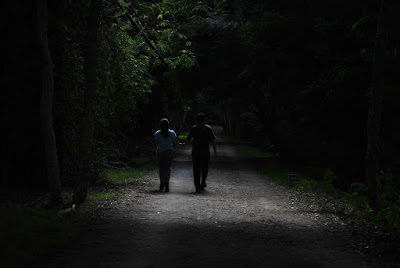 During the time of the marriage they were both a little shy, a bit reserved (naturally). The amount of progress they made in one year (not necessarily them in particular. I'm referring to all married couple) was tremendous. I took this photo during their first visit. There are 2 ways of looking at this photo.. Their holding hands and walking together tells us that they are comfortable with each other, they depend on each other, and more basically they do love each other and they're happy with each other.
During the time of the marriage they were both a little shy, a bit reserved (naturally). The amount of progress they made in one year (not necessarily them in particular. I'm referring to all married couple) was tremendous. I took this photo during their first visit. There are 2 ways of looking at this photo.. Their holding hands and walking together tells us that they are comfortable with each other, they depend on each other, and more basically they do love each other and they're happy with each other.
The other way of looking at this photo is like this. You see a lot of bright areas and dark areas in this frame. The white area represents the happy times or the times of joy. The darker area represents the tough times. And what is it they are doing? They are holding hands and walking through the happy and sad times together.. Supporting each other, always being there for each other. Life is not only about the happy times. Life is a healthy mixture of the happy and unhappy moments. That's the way it is. And its up to you who you want to share it with.
They are very happy with their lives and they very recently celebrated 1st birthday of their son (MY Nephew).
its been more than 4 years since my sister got married and moved to USA.. and yet the memory of her living here seems to be so fresh. I mean no surprises there we lived under the same roof for 18 years. My brother-in-law is a great guy. Very driven. Very focused.
Me and my sister were very close.. sure we would argue.. but we were so close. I used to think as she grew older and started college she would spend less time with me and more time with her peers. but fortunately that wasn't the case. She always took me out. She made plans with me she helped me out she was a great sister and she was a very reasonable person. She used to be patient with me and teach me and help me with my school stuff.. I was a slow learner she never lost her temper with me.
And as a second born, there are things you don't get to do. you don't get to create new rules. you only get to follow rules created by the first born. its the same in any household where i come from. let me give you an example.. my sister could stay out till say 10pm and for me to stay out till 10pm I had to be her age(which was unfair because all my friends could stay out till 10pm because they were all first born children). And whatever I get I used to get second hand. Like mobile phones or bicycles ad things like that. Hey I'm not complaining don't get me wrong these things taught me great values and value for money. Now I think twice before I buy anything for that matter. sometimes I miss her a lot.
anyway, like I said, its been more than 4 years since she moved to USA and she visited us I think 3 times.
This photo was taken the first time she visited us. I think it had been a little more than a year since she got married.
Oh and there's one more thing you have to know. My sister met my brother-in-law about 6 months before marriage. And in these 6 months they only used to communicate through Skype because he was in USA.
 During the time of the marriage they were both a little shy, a bit reserved (naturally). The amount of progress they made in one year (not necessarily them in particular. I'm referring to all married couple) was tremendous. I took this photo during their first visit. There are 2 ways of looking at this photo.. Their holding hands and walking together tells us that they are comfortable with each other, they depend on each other, and more basically they do love each other and they're happy with each other.
During the time of the marriage they were both a little shy, a bit reserved (naturally). The amount of progress they made in one year (not necessarily them in particular. I'm referring to all married couple) was tremendous. I took this photo during their first visit. There are 2 ways of looking at this photo.. Their holding hands and walking together tells us that they are comfortable with each other, they depend on each other, and more basically they do love each other and they're happy with each other.The other way of looking at this photo is like this. You see a lot of bright areas and dark areas in this frame. The white area represents the happy times or the times of joy. The darker area represents the tough times. And what is it they are doing? They are holding hands and walking through the happy and sad times together.. Supporting each other, always being there for each other. Life is not only about the happy times. Life is a healthy mixture of the happy and unhappy moments. That's the way it is. And its up to you who you want to share it with.
They are very happy with their lives and they very recently celebrated 1st birthday of their son (MY Nephew).
Sunday, June 22, 2014
Education
hola!
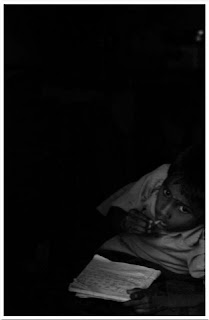 Almost all the teenagers don't know anything about taxes, or most of the things related to banking. this is a modern society and they should be teaching about survival in this modern society. do you have any idea how difficult it is for this child to get a descent education? consider this: she is in primary school. after primary comes high school. if there is high school in her village, its well and good. but if its not, she has to travel to a town. which will be a whole new world for her. naturally. and after that comes college. one can only imagine how difficult it will be for her to get basic education. But that's not the point of this photograph. no no no. this photograph speaks for itself. this is a natural photo. i did not tell her to pose. well, this is how it is here. have a good one!
Almost all the teenagers don't know anything about taxes, or most of the things related to banking. this is a modern society and they should be teaching about survival in this modern society. do you have any idea how difficult it is for this child to get a descent education? consider this: she is in primary school. after primary comes high school. if there is high school in her village, its well and good. but if its not, she has to travel to a town. which will be a whole new world for her. naturally. and after that comes college. one can only imagine how difficult it will be for her to get basic education. But that's not the point of this photograph. no no no. this photograph speaks for itself. this is a natural photo. i did not tell her to pose. well, this is how it is here. have a good one!
50 kilometers south of Mysore, there lies a village.. amongst a huge jungle. well outskirts of a forest to be precise. its not completely isolated from the forest either. there are constant sightings of wild animals like elephants and leopards. not a place for the faint of heart! wonderful place really! if you have forest surrounding one side of the village there is a huge lake on the other side and a national park too! one of the least polluted places around Mysore. the common occupation in this village is mostly farming.
This is a picture of one of the farmer's daughter. it was around 5 o'clock in the evening. she had just come back from the local school. this was an amazing sight really. I'm pretty she was either doing her homework or practicing what she was taught at school that day. she did this all by herself. no one told her to study. i was right there. Au contraire we city folks need need someone to poke us around to study ey?
We wont know the true value of the things we get easily or things which are given to us. we take it for granted and tend to misuse them. this was exactly my case back when i was a kid. my mother always used to make me study. i wasn't so good at studies even from the beginning. To be honest i never really understood the education system in my country. most of the topics i studied is a complete waste which i'm pretty sure that i would never use them anywhere in my life.
 Almost all the teenagers don't know anything about taxes, or most of the things related to banking. this is a modern society and they should be teaching about survival in this modern society. do you have any idea how difficult it is for this child to get a descent education? consider this: she is in primary school. after primary comes high school. if there is high school in her village, its well and good. but if its not, she has to travel to a town. which will be a whole new world for her. naturally. and after that comes college. one can only imagine how difficult it will be for her to get basic education. But that's not the point of this photograph. no no no. this photograph speaks for itself. this is a natural photo. i did not tell her to pose. well, this is how it is here. have a good one!
Almost all the teenagers don't know anything about taxes, or most of the things related to banking. this is a modern society and they should be teaching about survival in this modern society. do you have any idea how difficult it is for this child to get a descent education? consider this: she is in primary school. after primary comes high school. if there is high school in her village, its well and good. but if its not, she has to travel to a town. which will be a whole new world for her. naturally. and after that comes college. one can only imagine how difficult it will be for her to get basic education. But that's not the point of this photograph. no no no. this photograph speaks for itself. this is a natural photo. i did not tell her to pose. well, this is how it is here. have a good one!
please feel free to comment
Friday, June 20, 2014
peace
Greetings my friend
They say that you can maximize your work if you listen to your favorite in the background when doing work.. it really works! it really does.. lightens your mind. if you have not experienced this, then you probably haven't found YOUR type of music yet.. keep looking you'll get there. the feeling is amazing!
State Of Mind. responsible for most of our behavior.. and its all controlled by chemicals.. secreted in terms of milligrams! that's a few drops! can turn a raging person calm in just a few seconds.. and these chemicals are secreted believe it or not under our command.. sometimes music helps us change mood effectively..
this particular photograph was taken at the local market in my hometown.. this market is running from the time of the kings! mostly fruits and vegetables are sold in this market.. interesting place. very nice people. a lot of activities round the clock! total chaos all over. and among this sea of people screaming shouting trying to sell their produce, lies a man all by himself.. eyes closed.. fingers intertwined.. sitting. thinking.
This person sold flowers sitting in the corner of an alley. he didn't have a very good sale that day. i could tell because he had all the flowers right in front of him.. no sale=no money. no money is no survival.. so we are taught.
and yet he does not look worried one bit. Its like he is at peace. how? why? i know people who earn a million times more than this person. and yet cannot afford a fragment of his state of mind.. why is that? we revolve around a society where money is the center.
Humans are the only organism in the world who need money to survive. how crazy is that! our intelligence is our greatest gift and our greatest curse.
i am all out of words to describe this picture. just remember that money isn't everything. no matter how much money you have, you cannot put a price on peace. all the money in the world cannot bring you peace. it is something you have to find yourself. money may have a value.. but a person without values is nothing.
Friday, June 6, 2014
phone call to heaven.
greetings amigos!
so the past couple of weeks have not been good on me.. i had my finals and stuff.
This particular photograph that you will see was taken in Virajpet. for those of you who do not know where that is, its in karnataka, south india. beautiful place. beautiful weather.
this was taken more or less a year back. back then i was very bad with captions. this caption was given by the person who taught me photography(my uncle). not that im good with titles now! just saying.
so there is this hill in Virajpet. inaccessible by the average hatchbacks or sedans. only a 4x4 or a jeep would get you on top of that hill.. we can also reach the top by foot. there is a tradition the locals follow. no one is allowed to let his/her slippers touch the ground where the hill is situated. so you can either leave them back home or leave them in your car. you only have to go barefoot. i dont know the reason or history behind that.
its a thrilling ride to the top. and once you get to the top the view is truly amazing.
there is a temple on top of that hill.. also amazing! its like an open temple.. bells hung all around put up by devotees. visitors/devotees/travelers carry a bell to the top of the temple and hang it there for the blessings form the god. each bell has its own story. there is a lot of hidden meanings and back story behind each and every bell.
 some may wish for a better future. some may wish to do better in exam. some may wish for for money and what not.
some may wish for a better future. some may wish to do better in exam. some may wish for for money and what not.we always ask for what we want. i dont know how it is in the rest of the world.. from what ive seen prayer for me from a very early age is "ವೊಳ್ಳೆ ಬುದ್ದಿ ಕೊಟ್ಟು ವಿದ್ಯಾ ಬುದ್ದಿ ಕೊಟ್ಟು ಕಾಪಾಡಪ್ಪ". meaning: give me knowledge. give me nous and protect me.
From as long as i could remember and from when i could start talking thats what i used to say.. until a couple of years back that is.. but then i realized something. We always ask for what we want. but do we ever thank god?
we should really learn to be happy with what we have.
so next time you pray, thank the gods for all the beautiful things in life.. and just remember EVERYTHING HAPPENS FOR A REASON. every problem has a solution. we just have to look closely.. and if you've been looking too close, widen your angle. you will get the answer. ITS ALL ABOUT REALIZATION
Popular Posts
-
Landscape Photography Landscape photography shows spaces within the world, sometimes vast and unending, but other times microscopic....
-
Filters In photography and videography, a filter is a camera accessory consisting of an optical filter that can be inserted into ...
-
Aerial Photography Aerial photography is the taking of photographs of the ground from an elevated/direct-down position. Usua...
-
Street photography is photography conducted for art or enquiry that features unmediated chance encounters and random incidents within...
-
Its amazing how things work out.. I've been wanting to write this post from January of last year. Finally found the time and motivation...
-
Abstract Photography Abstract photography is my personal favourite kind of photography. I have always been fascinated by the creativity...
-
Food Photography Food photography is a still life photography genre used to create attractive still life photographs of food. It ...








